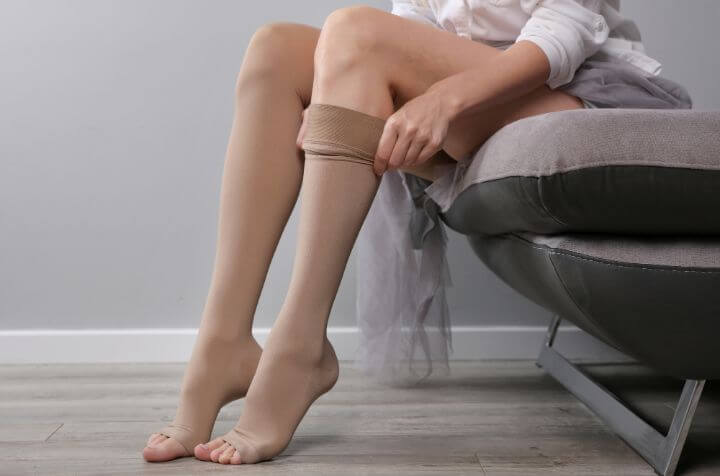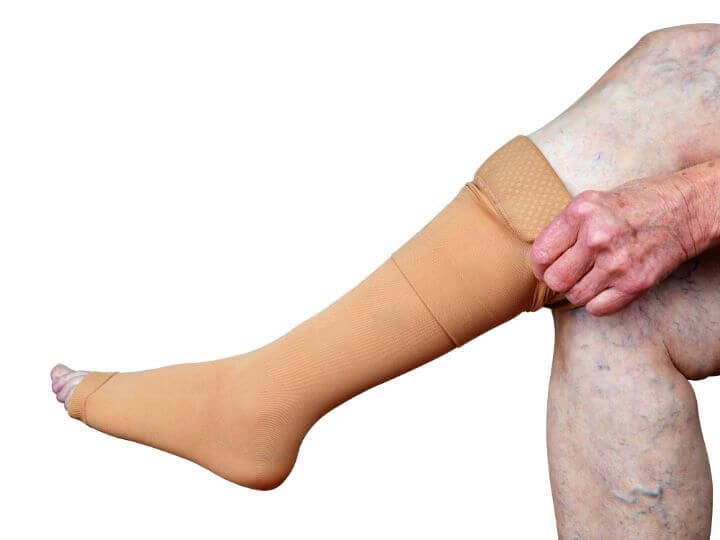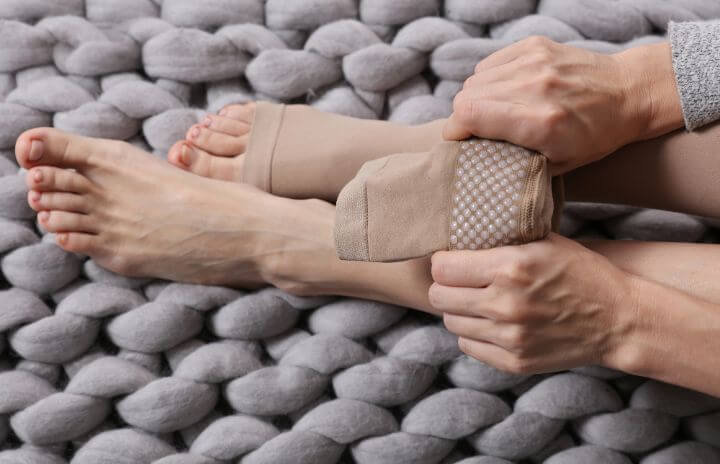Knee replacement surgery is a major operation. It involves replacing some or all parts of the knee joint that have worn off over time due to traumatic or degenerative conditions.
Complications are rare after this surgery. However, swelling, lymphoedema, and hemarthrosis could be a cause for concern. They usually occur in the early postoperative period and could prolong the rehabilitation process.
Another fallout of this surgery is deep vein thrombosis or DVT. It occurs when a blood clot forms in a vein deep inside the body due to reduced mobility in the initial few weeks. Doctors recommend the use of compression stockings at this time for about 6 weeks. They help boost the rehabilitation process.
Read on to know more about compression stockings and why they are a must after knee replacement surgery.
Contents
What Are Compression Stockings?
Before discussing the whys and hows about compression stockings, it is essential to understand what they are?
Compression stockings are snug-fitting, stretchy socks. They put gentle pressure on your leg to help the blood vessels work better.
The compression socks relax the arteries that take oxygen-rich blood to the muscles for easy blood flow. They also allow the veins to push back the blood to the heart efficiently.
Compression stockings allow the blood to move continuously. Thus, it is harder for the blood to pool in the veins and make any clot. If a clot formed breaks free, it can get stuck somewhere. It can be dangerous if the blood clot gets stuck in places like the lungs or brain. It could be fatal.
You may like our article on chairs for knee replacement patients
How Long Do You Have to Wear Compression Stockings?
The duration needed to wear compression stockings is based entirely on how severe DVT is. The doctor will examine your condition based on previous medical records and other ailments. Only after that will he recommend the usage duration.
In general, most patients are recommended to use compression stockings for about 2-8 weeks. The stockings should be worn at all times except during bathing.
You might also like Pros and Cons of Partial Knee Replacement
Who Needs Compression Stockings?
People with higher chances of getting DVT are advised to wear compression stockings. Once admitted to the hospital for knee replacement surgery, the doctor will check your risk of developing DVT.
After which, he will recommend the usage of compression stockings. Following people are at a high risk of developing DVT :
- Obese people
- If you have had DVT before
- People having cancer or undergone heart failure
- People with varicose veins
Some temporary situations can also lead to DVT, such as:
- If you have to be under general anesthesia for more than 90 minutes
- If you are having a hip, knee, leg, or abdomen surgery and your mobility is restricted for long
- If you have to spend long hours sitting in a chair
- If you are confined to bed
Knee replacement surgery reduces mobility to a great extent. Thus, it is recommended for most patients to wear compression stockings for about two weeks after being discharged.
What Are the Different Kinds of Compression Stockings?
Doctors recommend different types of stockings and sleeves in varying lengths for different parts of the body. Most of the stockings go just below the knee, but there are thigh-high ones too.
Each of them has different levels of pressure that are measured in mmHg. The range is between 10 mmHg and 60 mmHg, the latter having maximum compression. These stockings have to feel snug but not painfully tight. Thus, mild compression with low numbers is good enough to keep you comfortable.
However, for some people, higher numbers with a firmer fit are needed to prevent DVT. Here are the three types of compression stockings:
- Graduated compression stockings: These apply maximum pressure at the ankle that gradually reduces towards the top. They are designed for ambulatory patients. They provide a specific amount of ankle pressure and graduation of compression.
- Thrombo-embolic deterrent (TED) stockings: TED hose or anti-embolism stockings are used to reduce DVT risk. They offer gradient pressure like graduation compression stockings. They are ideal for bedridden patients.
- Non-Medical support hosiery: These are elastic support stockings mainly used to provide relief to heavy and aching legs. They exert much lesser pressure than the above two stockings. Also, their compression is uniform. You can buy them over the counter too.
Often, TED and anti-embolism stockings are used interchangeably. However, they have different levels of compression and indications. Usually, graduated compression stockings are used after knee replacement surgery for DVT prophylaxis.
You might also like Yoga After Knee Replacement – A Complete Guide!
Benefits of Compression Stockings After Knee Replacement Surgery
Compression stockings are recommended as early postoperative care following a knee replacement surgery. Knee swelling after the surgery may affect postoperative mobilization and training. This could lead to complications like DVT.
However, with the help of compression stockings, you can prevent blood clot formation in the legs. There are many other added advantages of wearing compression stockings:
1. Faster Healing
Wearing compression stockings keeps the skin and the body in place. With this garment snuggly fit around your leg, there is less opportunity for something to stretch, open, or pop out. They keep the skin in one place, reducing the scar.
2. Reduction in Swelling
After surgery, the body’s natural reaction is to send thousands of cells and a lot of fluid to heal the area. This results in swelling, especially in the lower body area. Thus, edema or swelling is a normal reaction to any surgery or injury.
Compression stockings help break down the fluid buildup and thereby, reduce the swelling. In addition, use an ice pack to reduce the swelling and a knee pillow to elevate your knee during recovery or while sleeping.
3. Less Probability of Infections
Compression stockings also act like bandages. You put a band-aid on a cut to stop the blood and protect it from getting dirty and infected. Compression garments also work similarly. They fit tightly around the body and restrict environmental factors to get to it. They are made up of moisture-wicking cooling materials and don’t allow any sweat build up either.
You might also like Best Age for Knee Replacement Surgery
To Sum It Up
Healing can take time before you can go back to your daily task or hobbies like bike riding, running, skiing, hiking, etc.
Postoperative care is crucial for knee replacement surgery. Swelling in the knee joint and the associated DVT is one of the main problems faced after the operation. Thus, doctors recommend using compression stockings in the initial 6 weeks after leaving the hospital.
The stockings help reduce the swelling and pain from the surgery and stimulate healing. However, in doing so, it is vital to know how to wear them properly. It is critical to maintaining proper hygiene by washing them regularly too.
If you are planning to travel after your surgery, read how long after knee replacement can you fly?



